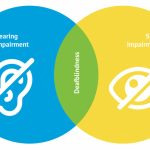7 Easy Home Adaptations for Children with Vision and Hearing Disabilities
Our homes should be safe havens, designed to meet the needs and preferences of all family members. Making a home accessible for children with vision and hearing disabilities is essential, and it can be done with a few simple modifications. Working with specialists who understand your child’s unique needs can provide valuable insights and specific recommendations, helping them navigate and function independently. Here are seven easy, practical, and commonly implemented home adaptations to consider:
Light and Lighting
When creating an accessible space for people with visual impairments, the first consideration should be the room’s lighting. The amount and intensity of light influence how well individuals can see. There isn’t a one-size-fits-all ideal light level, as this varies based on the specific vision condition, the task or activity being performed, and/or the amount of natural light available. Some people prefer natural light, while others find it too bright and need closed curtains. Individuals who find it difficult to cope with natural light may benefit from applying anti-glare film to their windows and using multiple light sources around the room instead of a single central light. In most cases, adaptable lighting, such as desk lamps and under-cabinet lights, is key, as it can be adjusted to suit different needs. While lighting can enhance visibility, it can also create challenges; therefore, it’s crucial to be mindful and prepared with quick solutions. Assess whether any light sources are distracting, and consider whether changes in the placement of furniture or window coverings might help. Additionally, evaluate lighting and glare around stairs, electronics, surfaces, and shiny floors to ensure a visually accessible environment. Using matte surfaces and paint on the walls can help reduce glare.
Color and Contrast
Color and contrast should be used thoughtfully. Using contrasting colors on doorways, light switches, and sockets can help children with low vision locate these items more easily. Even subtle contrasts, such as different shades of the same color, can effectively highlight areas and features. Painting skirting boards or door frames a different color from the walls can define room boundaries and make exit points more noticeable. Contrasting colors on flooring can indicate changes in room levels or the presence of steps, while highlighting the edges of steps with paint or tape enhances visibility. In bathrooms, tiles of contrasting colors can delineate essential areas like the shower, hand basin, and toilet. For better contrast, use bright colors. For instance, on dark backgrounds, white, yellow, and red work best, while on light backgrounds, black, blue, and greens are ideal. By implementing these adaptations, you can create a safer and more navigable home for children with vision disabilities.
Eliminate Clutter
Too many decorations or materials on walls can negatively impact accessibility, especially for children with Cortical/Cerebral Visual Impairment (CVI). Multiple areas with bright, attention-grabbing designs and colors can make it hard to know where to focus. Reducing decorations and amount of “clutter” on a wall can help a child focus and prevent distractions.
Keep the Space Organized
Organization is key to knowing where things are without having to search every time, particularly for those with low vision. Create systems that help you remember where items are, such as noting an object’s position among others. Group similar items, like toiletries and food, in specific places and label them with high contrast text and/or braille or tactile object symbols. Ensure your everyday items have a designated “home” and always return them to the same spot for easy location. An organized and predictable environment saves visual energy, making retrieval a motor memory and improving overall accessibility.
Monitor Noise
Research shows that extraneous noise hinders focusing and can impact visual skills, especially for individuals with CVI. In any environment, managing noise can be challenging, but there are effective ways to reduce it at home. Start by sitting in different areas to identify distracting sources of noise that could be minimized with a change in seating or layout. Pay attention to consistent, distracting sounds at certain times of the day and reduce visual demands by incorporating tactile and auditory approaches during high-noise periods. Adding pads or tennis balls to the bottom of chairs can reduce noise when moving them around. Limit playing music with lyrics during tasks that require concentration and provide processing time between auditory and visual activities or instructions. If noise is a significant issue, use areas with fewer adjoining walls to create a quieter environment. By monitoring and adjusting for noise, you can create a more conducive and comfortable living space.
Furniture Position
Adapting your home’s furniture positioning to accommodate a visually impaired family member requires thoughtful planning to enhance safety and accessibility. Furniture or partitions can assist in making areas clear to the individual with vision impairment. Clear areas make it easier for the person to understand where certain areas are such as the living room, the office, the play area, etc. This creates a predictable environment, as the person knows what to expect in each area. It also allows them to independently choose where they want to be depending on the activity. When placing furniture, it should be strategically placed around the border of the room. This promotes independence in the child who has a visual impairment because they won’t bump into tables in the middle of the room and can trail furniture to get to another area.
Technology
Incorporating smart home technology can significantly enhance the accessibility and safety of your home for visually impaired members. Smart doorbells with intercom systems allow you to check who is at the front door, while smart smoke detectors can shut off ventilation systems if gas is detected. Voice commands can control thermostats, lights, and other household devices, offering a hands-free way to manage your home. Start with simple upgrades like smart plugs and light bulbs, and gradually move to more complex appliances such as smart refrigerators. Technology can also enhance accessibility through digital adaptations like enlarged text, color coding, audio narration, and zooming into specific lines of text, which are free, built-in accessibility options on many devices. Laptops and tablets can further aid by providing enlarged fonts, color coding, and screen-sharing and also offer access to different apps, many of which are free to use. These technological adaptations, while not a substitute for comprehensive individualized support, offer valuable tools for creating a more accessible and user-friendly home environment.
It’s important to remember that not all adaptations need to be implemented at once. Each individual has unique needs, and it’s essential to assess and prioritize the changes that will be most beneficial. The recommendations provided in this article are designed to help create an environment where everyone can thrive.





